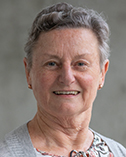
H. Jane Dyson
Scripps Research
|
Primary Section: 29, Biophysics and Computational Biology Secondary Section: 21, Biochemistry Membership Type:
Member
(elected 2022)
|
Biosketch
Jane Dyson is a structural biologist recognized for her work in protein folding, protein structure and dynamics, and intrinsically disordered proteins. She is known particularly for her delineation of the relationships between protein disorder and physiological function in transcription and other cellular processes, and in viral proteins. Dyson was born in Huddersfield, England and grew up in Australia. She graduated from the University of Sydney with a degree in biochemistry and a Ph.D. in inorganic chemistry. She was a postdoctoral fellow in biology at Massachusetts Institute of Technology and took up a faculty position as UNESCO lecturer in chemistry at the University of New South Wales in 1979. She moved to The Scripps Research Institute in 1984 and was appointed to the faculty in 1988. She served as editor-in-chief of the Biophysical Journal from 2017-2021.
Research Interests
Jane Dyson's laboratory is interested in the elucidation of the molecular basis of protein folding and the influence of local polypeptide chain dynamics on the function of enzymes. They have been particularly concerned with the elucidation of the role of intrinsically disordered proteins in cellular processes, and in the processes by which specific complexes of disordered and partly ordered domains of transcription factors, signaling proteins and cell-cycle proteins mediate function. Biophysical techniques such as circular dichroism and fluorescence, and, particularly, solution nuclear magnetic resonance (NMR) spectroscopy are used to probe the conformations of folded, partly folded and unfolded proteins in solution. Her lab has employed NMR to obtain structural and dynamic information in large protein complexes, including illuminating the role of unfolded and partially folded sequences in the IkB-NFkB system and the nature of the complexes of the chaperone Hsp90 with its clients and co-chaperones. For large, flexible complexes, structural and dynamic studies require the use of several complementary approaches, including techniques such as cryo-electron microscopy and small-angle X-ray scattering in addition to NMR to elucidate the composition and interactions of large complexes that contain both structured and unstructured components.

